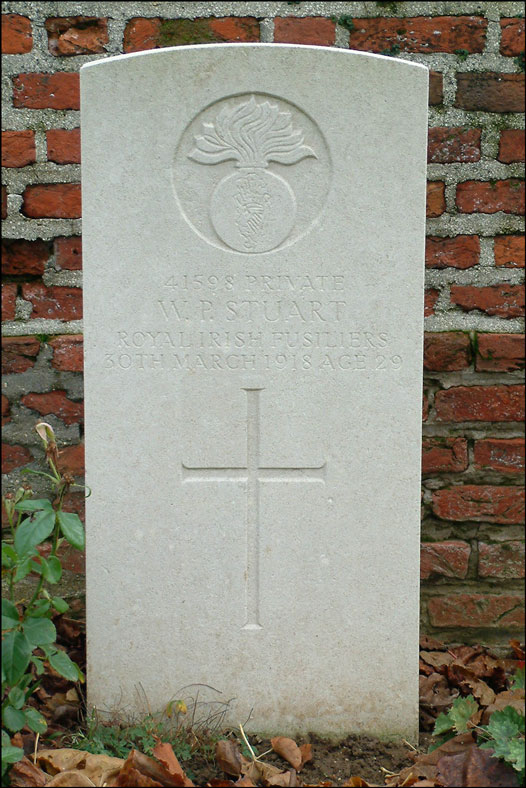![]() In memoriam
In memoriam ![]()
Private William Patrick Stuart
William Patrick Stuart was born on 23 December 1888 at 3 St Pancras Street, Ballymacarrett, Belfast, the youngest of seven children of upholsterer Andrew Stuart and his wife, Dumbarton-born Mary Stuart (nee O'Rorke). By 1911 he was living with his family at 6 New Bond Street, Belfast, and working as a house decorator.
Soon after this Stuart moved to England. By the end of 1915 he was working as a house painter and decorator and living at 188 Blake Street, Barrow, Cumbria. On 12 December 1915 he was attested into the army and placed in the reserve. He was mobilised on 20 November the following year and posted to the North Irish Horse, joining the regiment at Antrim two days later. He was issued regimental number 2312.
Stuart embarked for France on 24 April 1917, where he was posted to the 2nd North irish Horse Regiment. He joined his unit in the field at Boeschepe on 12 June.
Just weeks later orders came that the regiment would be dismounted and the men transferred to the infantry. Stuart was one of 70 men given the job of conducting the regiment's horses to Egypt. They embarked from Marseilles on board HMT Bohemian on 25 August. After a month at Alexandria they returned to France, through Italy. On 5 October they arrived at the 36th (Ulster) Division Infantry Base Depot at Harfleur for infantry training.
After just a few days they were posted to the 9th (Service) Battalion, Royal Irish Fusiliers – renamed the 9th (North Irish Horse) Battalion, joining it in the field at Ruyaulcourt on 12 October. Stuart was issued regimental number 41598 and posted to D Company. He probably saw action with the battalion during the Battle of Cambrai in November and December 1917.
Stuart was one of the many of the 9th Battalion listed as missing following the retreat from St Quentin from 21 to 28 March 1918, during the German spring offensive. In fact he had been captured, suffering from a serious head wound. He died in a German field hospital at Villers St Christophe on 30 March and was buried in the village churchyard.
Stuart's family did not learn of his fate until November 1918, when they received a letter from the Red Cross with information from Germany about his death.
After the war, when burial places were being consolidated, Stuart's grave could not be found. He is commemorated on a 'Kipling' Special Memorial at Ham British Cemetery, Muille-Villette, Somme, France (Villers St Christophe Churchyard Memorial 29).
The memorial inscription reads:
To the memory of these 5 British
soldiers, who died as Prisoners of War in
1918, and were buried at the time in
Villiers St. Christophe Churchyard, but
whose graves are now lost.
Their Glory shall not be blotted out.
...
41598 PRIVATE
W. P. STUART
ROYAL IRISH FUSILIERS
30TH MARCH 1918 AGE 29
Image kindly provided by Richard Evans. See his website Nelson, Glamorgan and the Great War http://www.nelson-ww1-memorial.org.uk.

